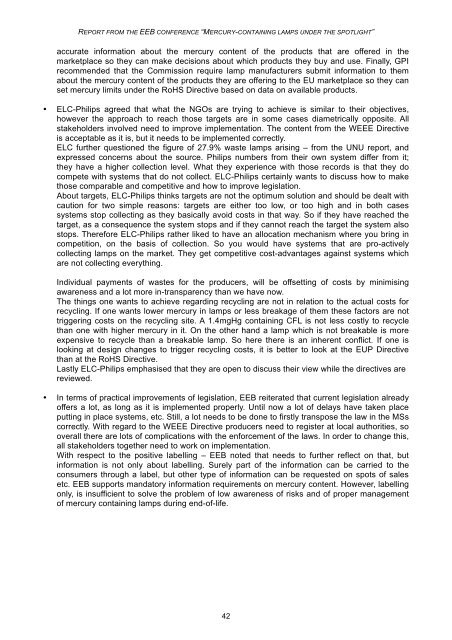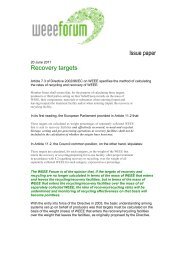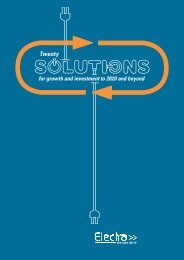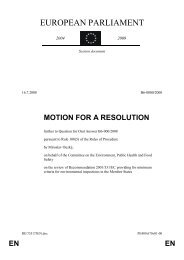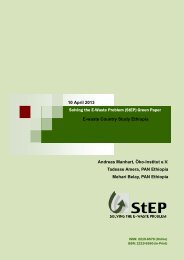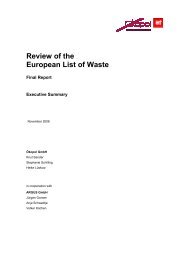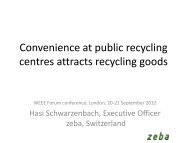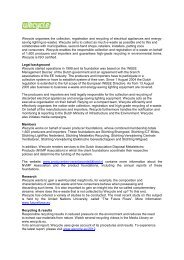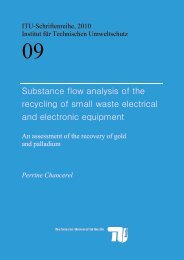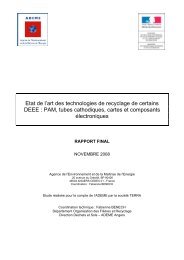Mercury containing lamps under the spotlight - WEEE Forum
Mercury containing lamps under the spotlight - WEEE Forum
Mercury containing lamps under the spotlight - WEEE Forum
Create successful ePaper yourself
Turn your PDF publications into a flip-book with our unique Google optimized e-Paper software.
REPORT FROM THE EEB CONFERENCE “MERCURY-CONTAINING LAMPS UNDER THE SPOTLIGHT”<br />
accurate information about <strong>the</strong> mercury content of <strong>the</strong> products that are offered in <strong>the</strong><br />
marketplace so <strong>the</strong>y can make decisions about which products <strong>the</strong>y buy and use. Finally, GPI<br />
recommended that <strong>the</strong> Commission require lamp manufacturers submit information to <strong>the</strong>m<br />
about <strong>the</strong> mercury content of <strong>the</strong> products <strong>the</strong>y are offering to <strong>the</strong> EU marketplace so <strong>the</strong>y can<br />
set mercury limits <strong>under</strong> <strong>the</strong> RoHS Directive based on data on available products.<br />
• ELC-Philips agreed that what <strong>the</strong> NGOs are trying to achieve is similar to <strong>the</strong>ir objectives,<br />
however <strong>the</strong> approach to reach those targets are in some cases diametrically opposite. All<br />
stakeholders involved need to improve implementation. The content from <strong>the</strong> <strong>WEEE</strong> Directive<br />
is acceptable as it is, but it needs to be implemented correctly.<br />
ELC fur<strong>the</strong>r questioned <strong>the</strong> figure of 27.9% waste <strong>lamps</strong> arising – from <strong>the</strong> UNU report, and<br />
expressed concerns about <strong>the</strong> source. Philips numbers from <strong>the</strong>ir own system differ from it;<br />
<strong>the</strong>y have a higher collection level. What <strong>the</strong>y experience with those records is that <strong>the</strong>y do<br />
compete with systems that do not collect. ELC-Philips certainly wants to discuss how to make<br />
those comparable and competitive and how to improve legislation.<br />
About targets, ELC-Philips thinks targets are not <strong>the</strong> optimum solution and should be dealt with<br />
caution for two simple reasons: targets are ei<strong>the</strong>r too low, or too high and in both cases<br />
systems stop collecting as <strong>the</strong>y basically avoid costs in that way. So if <strong>the</strong>y have reached <strong>the</strong><br />
target, as a consequence <strong>the</strong> system stops and if <strong>the</strong>y cannot reach <strong>the</strong> target <strong>the</strong> system also<br />
stops. Therefore ELC-Philips ra<strong>the</strong>r liked to have an allocation mechanism where you bring in<br />
competition, on <strong>the</strong> basis of collection. So you would have systems that are pro-actively<br />
collecting <strong>lamps</strong> on <strong>the</strong> market. They get competitive cost-advantages against systems which<br />
are not collecting everything.<br />
Individual payments of wastes for <strong>the</strong> producers, will be offsetting of costs by minimising<br />
awareness and a lot more in-transparency than we have now.<br />
The things one wants to achieve regarding recycling are not in relation to <strong>the</strong> actual costs for<br />
recycling. If one wants lower mercury in <strong>lamps</strong> or less breakage of <strong>the</strong>m <strong>the</strong>se factors are not<br />
triggering costs on <strong>the</strong> recycling site. A 1.4mgHg <strong>containing</strong> CFL is not less costly to recycle<br />
than one with higher mercury in it. On <strong>the</strong> o<strong>the</strong>r hand a lamp which is not breakable is more<br />
expensive to recycle than a breakable lamp. So here <strong>the</strong>re is an inherent conflict. If one is<br />
looking at design changes to trigger recycling costs, it is better to look at <strong>the</strong> EUP Directive<br />
than at <strong>the</strong> RoHS Directive.<br />
Lastly ELC-Philips emphasised that <strong>the</strong>y are open to discuss <strong>the</strong>ir view while <strong>the</strong> directives are<br />
reviewed.<br />
• In terms of practical improvements of legislation, EEB reiterated that current legislation already<br />
offers a lot, as long as it is implemented properly. Until now a lot of delays have taken place<br />
putting in place systems, etc. Still, a lot needs to be done to firstly transpose <strong>the</strong> law in <strong>the</strong> MSs<br />
correctly. With regard to <strong>the</strong> <strong>WEEE</strong> Directive producers need to register at local authorities, so<br />
overall <strong>the</strong>re are lots of complications with <strong>the</strong> enforcement of <strong>the</strong> laws. In order to change this,<br />
all stakeholders toge<strong>the</strong>r need to work on implementation.<br />
With respect to <strong>the</strong> positive labelling – EEB noted that needs to fur<strong>the</strong>r reflect on that, but<br />
information is not only about labelling. Surely part of <strong>the</strong> information can be carried to <strong>the</strong><br />
consumers through a label, but o<strong>the</strong>r type of information can be requested on spots of sales<br />
etc. EEB supports mandatory information requirements on mercury content. However, labelling<br />
only, is insufficient to solve <strong>the</strong> problem of low awareness of risks and of proper management<br />
of mercury <strong>containing</strong> <strong>lamps</strong> during end-of-life.<br />
42


